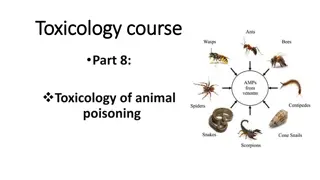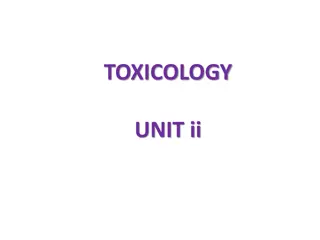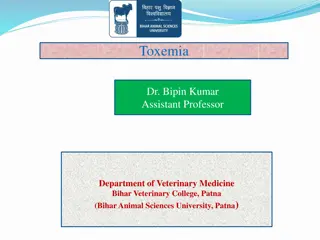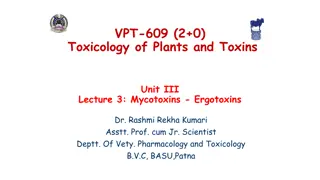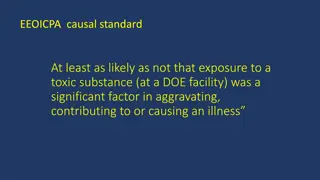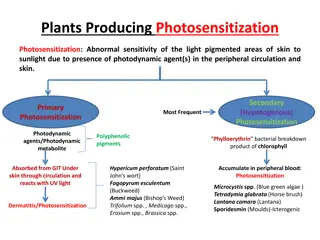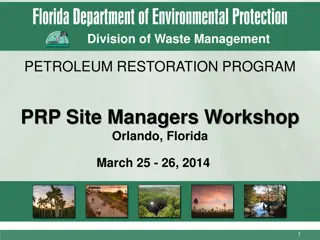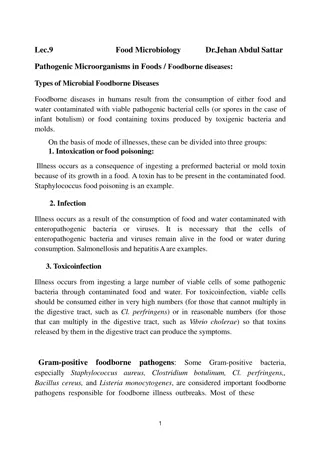Understanding Cyanobacterial Toxins Workshop
Explore the comprehensive workshop developed by RCAP/AWWA and funded by the USEPA on cyanobacterial toxins. Learn about the basics of cyanobacteria toxins, understanding when and why they occur, taking necessary actions, and limiting exposure. Delve into topics such as terminology, harmful algal blooms, evaluation of contamination risks, and classes of toxins. Gain insights into the impact, growth, monitoring, and prevention of cyanotoxins. Discover the significance of water quality monitoring and creating action plans to address cyanobacterial toxins effectively.
Download Presentation

Please find below an Image/Link to download the presentation.
The content on the website is provided AS IS for your information and personal use only. It may not be sold, licensed, or shared on other websites without obtaining consent from the author. Download presentation by click this link. If you encounter any issues during the download, it is possible that the publisher has removed the file from their server.
E N D
Presentation Transcript
Cyanobacterial toxins Workshop developed by RCAP/AWWA and funded by the USEPA
Learning Objectives Have a basic understanding of how, when and why cyanobacteria toxins occur Know when you need to take action Be able to make informed about how to limit exposure to cyanotoxins
Agenda Understanding cyanobacterial toxins Terms, regulations Impacts How they grow Monitoring Taking action Prevent blooms from occurring Removal of intact cyanobacteria Treatment for toxins Create an action plan
Evaluating cyanotoxin contamination risk A Water Utility Manager s Guide to Cyanotoxins (2015) Self-assessment helps determine risk level Assesses three areas source water monitoring source water quality cyanobacteria presence during treatment process
Terminology Harmful Algal Blooms (HABs) Cyanobacteria Cyanotoxins Developed by AWWA in partnership with RCAP and funded by USEPA, Published 2015
Harmful algal blooms (HABs) Rapid increase or accumulation in the population of algae Can refer to different types of algal bloom Cyanobacteria Green algal Red tide (marine) Developed by AWWA in partnership with RCAP and funded by USEPA, Published 2015
Cyanobacteria Blue-green algae Naturally found in surface water Can rapidly multiply Can produce dense mats www.epa.gov
What are cyanotoxins? Toxins produced by cyanobacteria Contained within cyanobacteria cells Usually released into water during cell rupture or cell death
Classes of toxins Microcystins: Cylindrospermopsin Anatoxins Saxitoxins Developed by AWWA in partnership with RCAP and funded by USEPA, Published 2015
EPA estimates that between 30 to 48 million people using drinking water from lakes and reservoirs may be vulnerable to cyanotoxins EPA Recommendations for Public Water Systems to Manage Cyanotoxins in Drinking Water, 2015 Developed by AWWA in partnership with RCAP and funded by USEPA, Published 2015
Federal Regulations Safe Drinking Water Act, Clean Water Act Currently, no federal regulations address cyanobacteria and their toxins
Federal Regulations (cont.) Contaminant Candidate List (CCL) List of potential drinking water contaminants that are currently unregulated (not all- inclusive) Identifies contaminants in need of additional study to determine whether or not they require regulation under the Safe Drinking Water Act
EPAs Unregulated Contaminant Monitoring Rule 4 (2018 -2020) Covers all systems with populations > 10,000 and 800 randomly selected small systems Lists unregulated contaminants to be monitored by public water systems Includes 10 cyanotoxins (9 cyanotoxins and 1 cyanotoxin group)
EPA Drinking Water Health Advisories (HAs) Young children more susceptible Microcystins Cylindrospermopsin Age Microcystins Cylindrospermopsin Children under 6 years old 0.3 g/L 0.7 g/L 6 year old through adults 1.6 g/L 3.0 g/L
Knowledge Checkpoint The Safe Drinking Water Act (SDWA) and the Clean Water Act regulate contaminant levels for cyanobacteria and cyanotoxins in drinking water. True or False?
Cyanotoxins and human health Can be acute or chronic Liver, nervous system, and gastrointestinal system impacts Range from a mild skin rash to serious illness or death
Human exposure to cyanotoxins can occur in several ways Ingesting contaminated water or fish Skin contact with contaminated water Inhaling or ingesting aerosolized toxins
Other potential water quality issues Taste and odor issues Increased raw water turbidity Increased disinfection byproduct precursors
Other impacts of cyanobacteria Adverse ecosystem impacts from hypoxia Drinking and recreational water quality concerns Economic losses
Challenges for water utilities Increase operational costs Develop and implement cost effective methods to reduce blooms in source waters Prevent, predict, analyze, monitor, and treat toxins Determine how to communicate risk to the public
Knowledge Checkpoint Describe some of the negative impacts of cyanobacterial blooms
Cyanobacteria types Most common genera: Anabaena Microcystis Planktothrix M57 Algae: Source to Treatment, First Edition
Initial indicators of cyanobacterial bloom Surface water discoloration (a red, green, or brown tint) Thick, mat-like accumulations on the shoreline and surface Fish kills
Early warning signs of a cyanobacteria bloom Increases in algal counts and turbidity Strengthening or weakening of the thermocline i.e. when turnover is beginning to take place Increases in pH
Leading factors causing blooms Excess nutrients (nitrogen and phosphorus) Slow moving surface water Elevated water temperature
Variation in cyanobacteria blooms Does not always mean cyanotoxin issue Multiple cyanobacteria strains in a single bloom Not all cyanobacteria are capable of producing cyanotoxins
Discussion Question How would you recognize if a bloom is occurring? What would you do, who would you report it to? Developed by AWWA in partnership with RCAP and funded by USEPA, Published 2015
Knowledge Checkpoint Which of these is not an early warning indicator for a cyanobacteria bloom? a. The water turns a red, brown, or green color b. Increases in turbidity c. Increased light penetration d. Fall or spring turnover is about to take place
Source water monitoring Developed by AWWA in partnership with RCAP and funded by USEPA, Published 2015
Cyanobacteria & Cyanotoxin monitoring Frequent, detailed, specific Different intake depths/location, if available
Routine monitoring Visual inspection Cell counts Measure Chlorophyll a Developed by AWWA in partnership with RCAP and funded by USEPA, Published 2015
Common laboratory methods for cyanotoxins Enzyme linked immunosorbent assays (ELISA) - Screening High performance liquid chromatographic methods (HPLC) with: ultraviolet/photodiode array detectors (UV/PDA) mass spectrometric (MS,MS/MS)
Collecting water samples for toxin analysis Collection Store samples in amber containers to minimize exposure to sunlight Quenching Quench with sodium thiosulfate or ascorbic acid Chilling Place on ice, sample freezing may be appropriate to extend holding times
What can you do? 1. Prevent a bloom from occurring 2. Remove cyanobacteria intact 3. Treat for toxins Developed by AWWA in partnership with RCAP and funded by USEPA, Published 2015
Effective preventative measures Control anthropogenic influences that promote blooms (leaching and runoff of excess nutrients) Water column mixing Increasing water flow Adjust depth of water intake
Treatment Developed by AWWA in partnership with RCAP and funded by USEPA, Published 2015
Treatment for cyanotoxins The majority of toxins are contained within cyanobacteria cells. (intracellular) If possible, removal cyanobacteria without disrupting cells More difficult to remove (extracellular) toxins in the water Developed by AWWA in partnership with RCAP and funded by USEPA, Published 2015
Treatment: intracellular cyanotoxins Conventional water treatment flocculation, coagulation, sedimentation and filtration Flotation Membranes Preoxidation May rupture cyanobacteria cells releasing the cyanotoxin to the water column.
Intracellular treatment processes A Water Utility Manager s Guide to Cyanotoxins, 2015, AWWA and Water Research Foundation
Treatment: extracellular cyanotoxins Conventional water treatment usually not effective Activated carbon: powdered (PAC) or granular (GAC) Chlorination is dependent on cyanotoxin
Extracellular treatment processes A Water Utility Manager s Guide to Cyanotoxins, 2015, AWWA and Water Research Foundation
Self-assessment: cyanobacteria in the treatment process A Water Utility Manager s Guide to Cyanotoxins, 2015, AWWA and Water Research Foundation
Contingency plan Monitoring Plan Management and Control Plan Communication plans
Activity: potential cyanotoxin events The Water Utility Manager s Guide to Cyanotoxins advises utilities to assess these 3 categories to determine their system s risk for potential cyanotoxin events: Source water monitoring Source water quality Cyanobacteria present during the treatment process For each category, provide one or more examples of actions that you can take to reduce risk.
AWWA Resources These resources are available at: https://www.awwa.org/resources-tools/water- knowledge/cyanotoxins.aspx Cyanotoxin Oxidation Calculator - CyanoTOX, Version 2 Managing Cyanotoxins in Drinking Water: A Technical Guidance Manual for Drinking Water Professionals Water Utility Managers Guide To Cyanotoxins Cyanotoxins in US Drinking Water: Occurrence, Case Studies and State Approaches to Regulation
Water Research Foundation (WRF) Resources For additional information please see WRF s video on Understanding Cyanobacteria and Cyanotoxins: https://www.youtube.com/watch?v=S9iyKdHt 5_c&t=5s Used with permission from the Water Research Foundation, 2018
EPA Cyanotoxin Tools for Public Water Systems These resources are available at: https://www.epa.gov/ground- water-and-drinking-water/cyanotoxin-tools-public-water-systems Recommendations for Public Water Systems to Manage Cyanotoxins in Drinking Water Cyanotoxin Management Plan Template and Example Plans Water Treatment Optimization for Cyanotoxins Drinking Water Cyanotoxin Risk Communication Toolbox
EPA Cyanotoxin Tools for Public Water Systems (cont.) These resources are available at: https://www.epa.gov/ground- water-and-drinking-water/cyanotoxin-tools-public-water-systems Cyanobacteria and Cyanotoxins: Information for Drinking Water Systems Fact Sheet Harmful Algal Blooms and Drinking Water Fact Sheet Possible Funding Sources for Managing Cyanobacterial Harmful Algal Blooms and Cyanotoxins in Drinking Water












